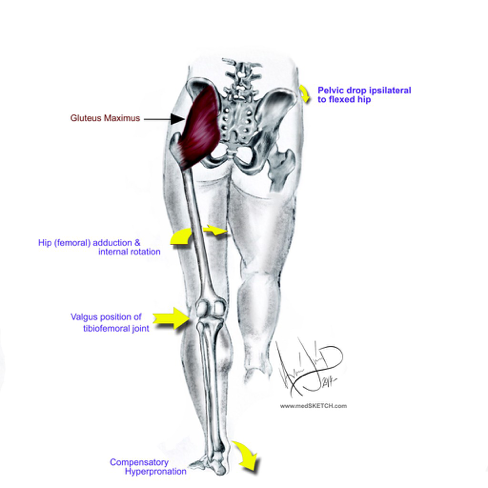5 Reasons You Have Bad Knees
We’re wrapping up our last full day in Paris before moving on to Prague to teach the Complete Shoulder & Hip workshop with Tony Gentilcore. It’s been a pretty eventful week in Europe so far, complete with switching hotel rooms multiple times due to malfunctioning air conditioning in London, rain every day in Paris, and hitting up museums and landmarks like no one’s business.
With that in mind, today’s guest post comes from Erica Suter, a soccer and strength coach from Baltimore, MD.
******
SEO is something I never was concerned about when I started blogging. Not only is it too much thought, it would deter me from writing in an authentic voice. Imagine if I dropped keywords EVERY SINGLE SENTENCE. Perhaps only my mom and dog would still be my only readers.
For this post, I oscillated between a myriad of titles. Sure, I could’ve paid attention to SEO like a real blogger and titled this post “5 Reasons Your Knees Are Getting Injured” or “5 Reasons Your Knees Are Not Stable.” Those would’ve been the safe route.
Then it came down to “5 Reasons Your Knees Are More Unstable than Miley Cyrus” or “5 Reasons You Have Bad Knees.”
I chose the latter. It seemed to have a better ring to it and was a good sweet spot between conventional and completely obscure. Also, don’t give a damn about SEO. Come at me, bro.
Because let’s face it. A lot of us have shitty knees, especially me.
Two meniscus repairs later and I’m still feeling wobbly. Though I do feel I’ve come a long way, and have made strides to a sturdier knee. After altering my training program and honing in on certain movement patterns, I’m beginning to feel more like my Wonder Woman self.
As a soccer coach to hundreds of female players, I feel it is my indirect soccer mom duty to ensure they don’t go through the same agony of knee surgery. It’s a long 9 months of hating life and watching your teammates frolick around freely on the pitch. Meanwhile, the most action you’re getting is watching Breaking Bad re-runs in bed while stuffing your face with takeout sushi.
This isn’t to say knee injuries can be glamorous. They aren’t. Needless to say, they’re something that should be prevented as much as possible.
As I’ve noted before, the causes of knee injuries are more than just the “girls have wider hips” argument. Can we please stop feeling sorry for females and their shitty anatomy?
Okay, good.
To tackle the problem of knee injuries, Baltimore-based physical therapist Dr. Eric Gordon will be chiming in as well. We got a doctor in the house…whoop, whoop!
Without further ado, here are 5 Reasons Your Knees Are Shitty (and what you can do):
1.) Your butt isn’t big enough.
Sir Mix-A-Lot was onto something when he said he “liked big butts” way back in 1992. Yes, big butts are attractive. They jiggle. They bounce. They shake. They twerk. But what other function do they serve?
Strong butts allow for external rotation of the hips, controlled deceleration during ground reaction forces, and knee stabilization via the IT band – all things that reduce the chance of ACL tears, meniscus tears, and patellofemoral pain.
The glutes also resist internal rotation, hip adduction, and hip flexion. The weaker the gluteals, the more load and medial pull there is on the femur, leading to a knee valgus shit storm.

The butt isn’t exclusive to the glutes, however. The hamstrings also play a critical role in ensuring there aren’t excessive forces placed on the quadriceps. Want to avoid being the idiot who tears an ACL just walking down the street? Stop living in a quad dominated world. Just stop.
Solution: Start to work toward a stronger dead lift. Other posterior chain accessory movements to consider would be single leg dead lifts, stability ball hamstring curls, hip thrusts, paused landmine dead lifts, or good mornings.
So get your ass big. Like REALLY BIG.
To further put things into perspective, would you rather be fighting high forces in a game of soccer, OR facing the stressors of daily life with a butt like this:
Or this:
Yeah. Thought so.
2.) You are training your core wrong.
Want to learn more than you need to know about the core? Good.
The core is one integrated unit also called the lumbo-pelvic hip complex (LPHC). It is comprised of the pelvis, lumbar spine, hip, and abdomen and trunk muscles – an interconnected web that helps with postural control and symmetry throughout the kinetic chain. Think of it as the trunk to a tree – if it break downs the rest of the parts fall to pieces.
Truthfully, I could nerd out and go on and on about the functional anatomy of the LPHC. However, I’ll leave it to Bret Contreras to write an extensive literature review and blow your mind with anatomy jargon.
So here’s what you need to know: the core should be trained in a way so that it can resist high levels of force. BUT ALSO, it should be trained to prevent excessive anterior pelvic tilt – a postural imbalance that will offset the rest of the kinetic chain.
Solution: Stop doing excessive spinal flexion. Rather, do cable chops, plank variations, pallof presses, medicine ball work, body saws, wheel rollouts, OR strengthen your compound movements (squats, dead lifts, pull ups). For more information, I’ve written more about core exercises here and here. Or try this rollout variation:
3.) You have pelvic and hip asymmetry.
Indeed, anatomy is hard to battle. Some people have wider hips. Some people have anterior pelvic tilt. Some people have a cringeworthy pelvic drop:
In the above picture, there is a contralateral drop of the pelvis, which causes the femur to internally rotate and adduct. Typically, this happens due to poor neuromuscular control, lack in activation of the gluteus medius, or asymmetry in adductor flexibility. According to Dr. Gordon, “No person is created with perfect symmetry and pristine mechanics.”
Wake up call: MOST of our bodies are this effed up.
Solution: Activate the problem side twice or even three times as much as the weaker side. Because let’s face it, you can’t get enough glute work. Here is a great article by Bret Contreras on fixing glute asymmetry. Perform exercises such as side-lying clams, standing clams, or control in the frontal plane during single leg work.
4.) You are not conditioned.
If you’re an elite athlete, proper conditioning is the difference between prevailing or totally falling apart in double overtime. Or if you’re a mom participating in a Tough Mudder, conditioning will allow you to carry your husband on your back through the barbed wire obstacle without blowing a knee. ;-0
Furthermore, conditioning is also the difference between maintaining optimal posture or returning back to ugly deviations and looking like the Hunchback of Notre Dame.
If you aren’t conditioned to play the length of your sport or power through the end of a marathon, your muscles will fatigue, causing prime movers fail, muscle compensations to increase, and injuries to occur.
And in soccer, posterior chain injuries occur the most at the end of each half.
Solution: High intensity interval training, dumbbell or kettlebell complexes, or high intensity continuous training are all viable routes to enhance conditioning.
5.) You don’t do enough balance and single leg training.
No matter how strong you are, lack of neuromuscular and proprioceptive training will still leave you at a high risk for knee injury.
Dr. Eric Gordon says, “Strength cannot be utilized to its full potential if proprioception is deficient.” Brilliant.
He adds, “If you have quadricep and hamstring strength yet they aren’t coordinated correctly, you are working at a less than optimum level and increasing your chance of injury.”
Here are a few drills to try:
This next one I like to do with my soccer players to make the drill more dynamic with some skill work. Progress this one by closing your eyes and then opening them before the ball is thrown.
You’ll notice that with your eyes closed the drill becomes more challenging.
Are You Still Paying Attention?
Admittedly, I’m surprised I made it through this long of a post without cracking open a bottle of wine. However, I’m so incredibly passionate about the interplay of knee kinematics and strength training that I can pump out a post quickly and effortlessly (sober or not). ;-0
So thank you for reading. I hope you enjoyed these 5 reasons you’re getting knee injures.
^Because, I had to drop some SEO.
About the Author
Erica Suter, CSCS, is a technical soccer trainer, strength coach, and free spirit based in Baltimore, MD. She is the owner of Energizing Soccer, an academy that focuses on soccer skills, strength training, and injury prevention. She specializes in training female soccer players, from youth to the Division 1 and 3 college level. You can read her blog at www.ericasuter.com for all things fitness, sarcasm, and strong soccer booties.






3 Responses to 5 Reasons You Have Bad Knees